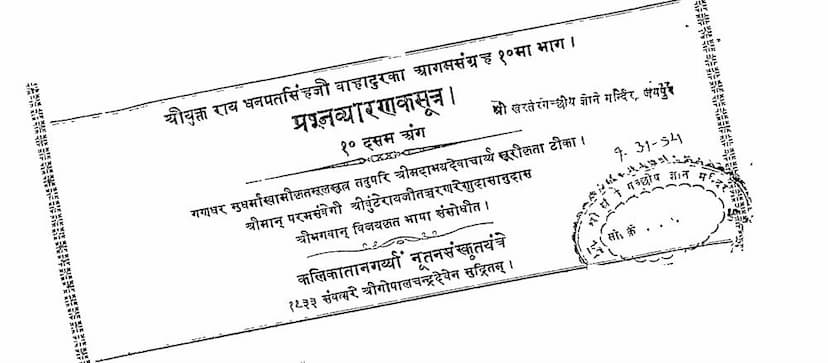Agam 10 Ang 10 Prashna Vyakaran Shwetambar
Added to library: September 1, 2025

Summary
This Jain text, titled "Agam 10 Ang 1 0 Prashna Vyakaran Shwetambar," authored by Rai Dhanpatsinh Bahadur and published by the same, is a significant work within the Shwetambar canon. It is the tenth Anga (limb) of the Agam literature, specifically focusing on the "Prashna Vyakaran" (inquiry and explanation) sutra.
The text is presented as a commentary ("Tika") by Acharya Abhayadeva Suri on the root sutra by Acharya Sudharma Swami, the disciple of Lord Mahavir. The edition was revised and corrected by Vijayrajji. The preface, written in Hindi, highlights the benevolent intention behind its publication: to spread knowledge among Jain monks, nuns, laymen, and laywomen. It also includes a personal note from Rai Dhanpatsinh Bahadur, mentioning his ancestry and the considerable effort involved in the compilation and revision.
The core content of the text, as evident from the initial pages, is an exposition of the Prashna Vyakaran sutra, the tenth Anga of the Jain Agamas. This Anga is known to delve into various aspects of spiritual practice, ethical conduct, and philosophical inquiries within Jainism. The early pages indicate a detailed breakdown of concepts, starting with the nature of "Ashrava" (influx of karma) and "Samvara" (cessation of karma), defining them as the essence of the Jain path.
The text seems to follow a commentary structure, elaborating on the root sutra with explanations, definitions, and examples. The initial chapters, as per the early pages, discuss the classification of Ashrava and Samvara, and their significance in achieving liberation. There's a narrative introduction mentioning Lord Mahavir, his disciple Sudharma Swami, and the context of the teachings being imparted to Jamvu (Jambu Swami).
The text further delves into the classification and characteristics of various karmic influxes (Ashravas) and cessations (Samvaras). It appears to detail the ethical principles and practices prescribed by Jainism, likely within the context of answering specific spiritual inquiries or "questions" as suggested by the title "Prashna Vyakaran." This includes detailed discussions on concepts like:
- Prana: Life force and its relation to karma.
- Ashrava: The various channels through which karmic matter enters the soul, classified into categories like violence (himsa), untruth (asatya), stealing (adatta), unchastity (abrahmacharya), and possession (parigraha).
- Samvara: The restraints and practices that prevent the influx of karma, corresponding to the aspects of Ahimsa (non-violence), Satya (truthfulness), Asteya (non-stealing), Brahmacharya (celibacy), and Aparigraha (non-possession).
The text meticulously elaborates on each of these principles, likely detailing their nuances, the actions that constitute them, and the consequences of adherence or non-adherence. For instance, the discussion on Ahimsa (non-violence) appears to be extensive, touching upon various forms of violence and their subtle manifestations, as well as the practices to counteract them. Similarly, the subsequent discussions on Satya (truthfulness), Asteya (non-stealing), Brahmacharya (celibacy), and Aparigraha (non-possession) would likely follow a similar pattern of detailed explanation and ethical guidance.
The language used is a form of Prakrit, common in ancient Jain texts, interspersed with Sanskrit terms and explanations. The structure indicates a scholarly and systematic approach to expounding these core Jain doctrines. The inclusion of genealogical information in the preface suggests a lineage and tradition associated with the text's transmission and publication.
Overall, this book is a comprehensive Jain scripture that aims to provide a deep understanding of the foundational concepts of karma, its influx, and its cessation, as taught in the Shwetambar tradition, guided by the principles of Ahimsa, Satya, Asteya, Brahmacharya, and Aparigraha. It serves as an important resource for understanding Jain ethics and spiritual practices.